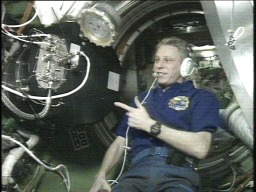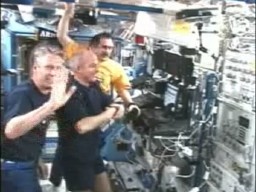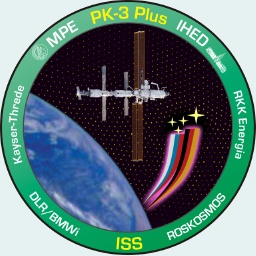''Plasma Crystal''
News 2006
|
December 2006
|

|
Thomas Reiter and 'PK-3 Plus' data back on Earth
On December 22 the space shuttle Discovery landed safely
on Runway 15 at the NASA Kennedy Space Center in Florida
returning German astronaut Thomas Reiter to Earth.
(Left image courtesy of
 NASA.)
Reiter served onboard the International Space Station
since July as a flight engineer completing the Expedition
13 and Expedition 14 crews. NASA.)
Reiter served onboard the International Space Station
since July as a flight engineer completing the Expedition
13 and Expedition 14 crews.
During his long term stay, Reiter performed the plasma crystal
experiment 'PK-3 Plus' six times. One of the goals was to
grow large plasma crystals in weightlessness for a structural
analysis. And Reiter even had fun doing our experiment, as he
confessed in an interview to the German news journal 'Der Spiegel':
''... Especially, in the experiment with complex plasmas,
which appear e.g. in fluorescent tubes, I saw spectacular effects
that were very astonishing for me. And through the radio I could
hear the surprise also to the scientists on Earth who invented
the experiment. Now, I'm very curious what the experts will
find after a closer analysis of the data.'' (
 DER SPIEGEL 49/2006, p 172) DER SPIEGEL 49/2006, p 172)
 The data, i.e. video clips of the microparticles in the
plasma, together with logged operating parameters, were
recorded on portable harddisk drives, which were returned
to Earth
(see right image)
together with Thomas Reiter with the successful
end of mission STS-116 onboard Discovery.
The scientists at MPE and the collaborating IHED institute,
Moscow, are curious about the data. New insights to the
physics of complex 'dusty' plasmas are expected.
The data, i.e. video clips of the microparticles in the
plasma, together with logged operating parameters, were
recorded on portable harddisk drives, which were returned
to Earth
(see right image)
together with Thomas Reiter with the successful
end of mission STS-116 onboard Discovery.
The scientists at MPE and the collaborating IHED institute,
Moscow, are curious about the data. New insights to the
physics of complex 'dusty' plasmas are expected.
|
October 2006
|

|
2x ZERO G
 In October two experiments of MPE will be performed in weightlessness.
German astronaut Thomas Reiter will operate the complex plasma
experiment PK-3 Plus on board the International Space Station ISS.
Main goal of this experiment session is the growth of large plasma
crystals and to analyze their structure.
In October two experiments of MPE will be performed in weightlessness.
German astronaut Thomas Reiter will operate the complex plasma
experiment PK-3 Plus on board the International Space Station ISS.
Main goal of this experiment session is the growth of large plasma
crystals and to analyze their structure.
A few days later MPE's PK-4 experiment -- intended to be on the ISS
in 2009 -- will be tested during ESA's 45th parabolic flight campaign.
The tests will focus on technical aspects of PK-4, namely the gas
system, a new gas jet dispenser and special electrodes for electrical
manipulation of the microparticles inside the plasma.
Scientists and engineers of MPE and IHED will be in Moscow (ISS ground
control center) and in Bordeaux-Mérignac, France, to conduct the
experiments.
On October 20, German TV station Phoenix broadcasts
a report about the plasma crystal experiment and the clinical
application of plasma technology, now being under investigation
in a collaboration between MPE and Hospital (Krankenhaus)
München-Schwabing.
 Click here to view. (German only.) Click here to view. (German only.)
|
August 2006
|

|
German astronaut Thomas Reiter to do plasma crystal experiment
Thomas Reiter, German astronaut onboard the International Space Station
ISS, will perform the MPE's new plasma crystal experiment
PK-3 Plus in space on August
18th another time.
Reiter (48) - living on the ISS since July 6th - enhances the
 Expedition 13 crew, made up by
Commander Pavel Vinogradov and Flight Engineer and NASA
Science Officer Jeffrey Williams, as 2nd flight engineer.
Including his stay on the space station Mir in
1995/96 the German has now accumulated the most time
in space of all European astronauts.
He gained experience in several space walks and holds a licence
for piloting the russian Soyuz spacecraft. Expedition 13 crew, made up by
Commander Pavel Vinogradov and Flight Engineer and NASA
Science Officer Jeffrey Williams, as 2nd flight engineer.
Including his stay on the space station Mir in
1995/96 the German has now accumulated the most time
in space of all European astronauts.
He gained experience in several space walks and holds a licence
for piloting the russian Soyuz spacecraft.
Two teams of the MPE follow the experiments in August on the
ground. One in Moscow from the Russian space control center and
one - as a test - from the German space control in Oberpfaffenhofen.
In case of success the latter may be used to conduct future plasma
crystal experiments in space from Germany.
The German TV station
 'Phoenix' will cover the experiment session in
August beginning at 22:45 MEDT. An interview with Prof.
Greg Morfill, director of MPE, is planned. 'Phoenix' will cover the experiment session in
August beginning at 22:45 MEDT. An interview with Prof.
Greg Morfill, director of MPE, is planned.
More:
 Press information of DLR Press information of DLR
|
March 2006
|

|
The PK-3 Plus Mission Patch
(Enlarge)
''The mission patch of 'PK-3 Plus' - MPE's next-generation plasma crystal
experiment - shows where the experiment is located: onboard the
International Space Station in Earth orbit. The background shows a
typical view of a plasma crystal which is also the background of the
experiment itself: the solid fundament layed by its successful precursor
plasma facility on ISS, 'PKE-Nefedov'. The ISS's orientation gives a hint
to the experiment's name - a big plus. The flags of the collaborating
nations, Russia and Germany, embedded in a light pink plasma glow, rise
from Earth and join in space. At the top end they support four star-like
features (particles, arranged in a crystal lattice, shining up in laser
light?) that also symbolize the experiment's name: THREE (small) and one
big PLUS-like stars. The star symbols are taken from NASA's STS-102 mission
that brought the Expedition One crew and the data tapes of the first
plasma crystal experiments from ISS back to Earth. The rim of the mission
patch names the collaborating institutes in Germany and Russia, together
with the symbols of their affiliation (Germany's Max-Planck-Gesellschaft
and Russian Academy of Science), the industrial partner companies and the
funding agencies. The colors are chosen from the mission patch of PKE-
Nefedov but the Three-Plus patch is now circular, to symbolize the level
of (instrumental) perfection achieved with this new spaceborn plasma
crystal facility, PK-3 Plus.''
© M. Kretschmer
|
January 2006
|

|
Valery Tokarev (picture),
flight engineer of the 12th ISS crew, performed the new plasma
crystal experiment 'PK-3 Plus' of the
MPE on January 12. PK-3 Plus was launched to the International Space
Station onboard a Russian Progress cargo ship in
December 2005. It will replace
the 'PKE-Nefedov' facility that is onboard the ISS since March
2001, having provided ground-breaking new insights into the physics
of complex ('dusty') plasmas in microgravity. 'Three Plus' will
allow to perform experiments with much higher precision,
promising even deeper knowledge of the phenomena in complex
plasmas.
German astronaut Thomas Reiter is also planned to do plasma crystal
experiments during his long term stay onboard the ISS in 2006.
( ESA press release) ESA press release)
PK-3 Plus was developed by MPE in collaboration with the Institute
for High Energy Density (IHED), Moscow, built by German company Kayser-Threde
(Munich) and RKK Energiya (Moscow), and financially supported by the
German Aerospace Research Center (DLR) and the Russian Space Agency
ROSKOSMOS.
See also press releases by
 DLR,
Astronews,
ESA,
ESA (Erasmus),
Kayser-Threde,
Wissensdurst,
Vanguardia (espanol),
El Universal,
Spaceref
(external links). DLR,
Astronews,
ESA,
ESA (Erasmus),
Kayser-Threde,
Wissensdurst,
Vanguardia (espanol),
El Universal,
Spaceref
(external links).
|
Updated: 2007-01-15
RS
Contact: Michael Kretschmer

|